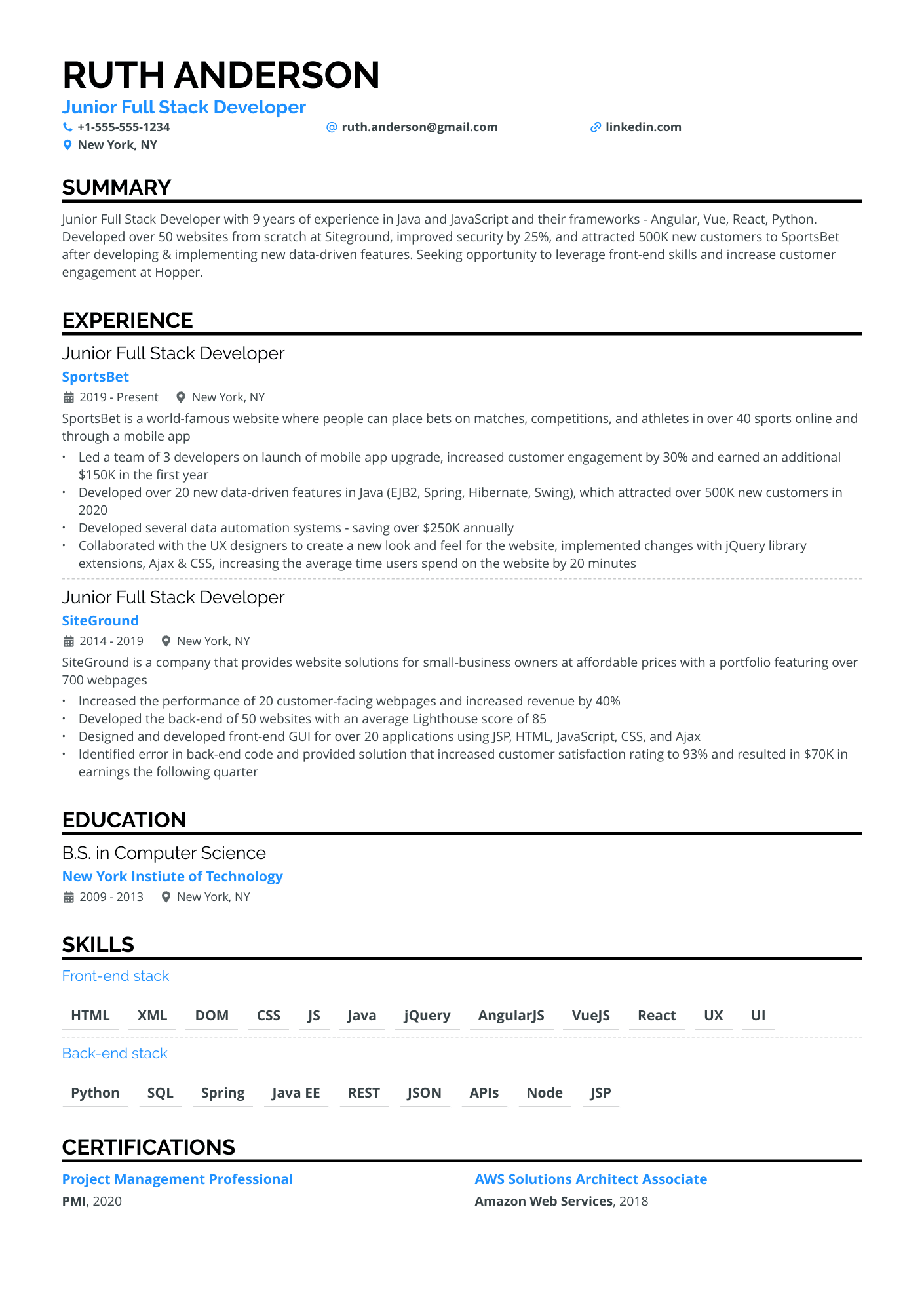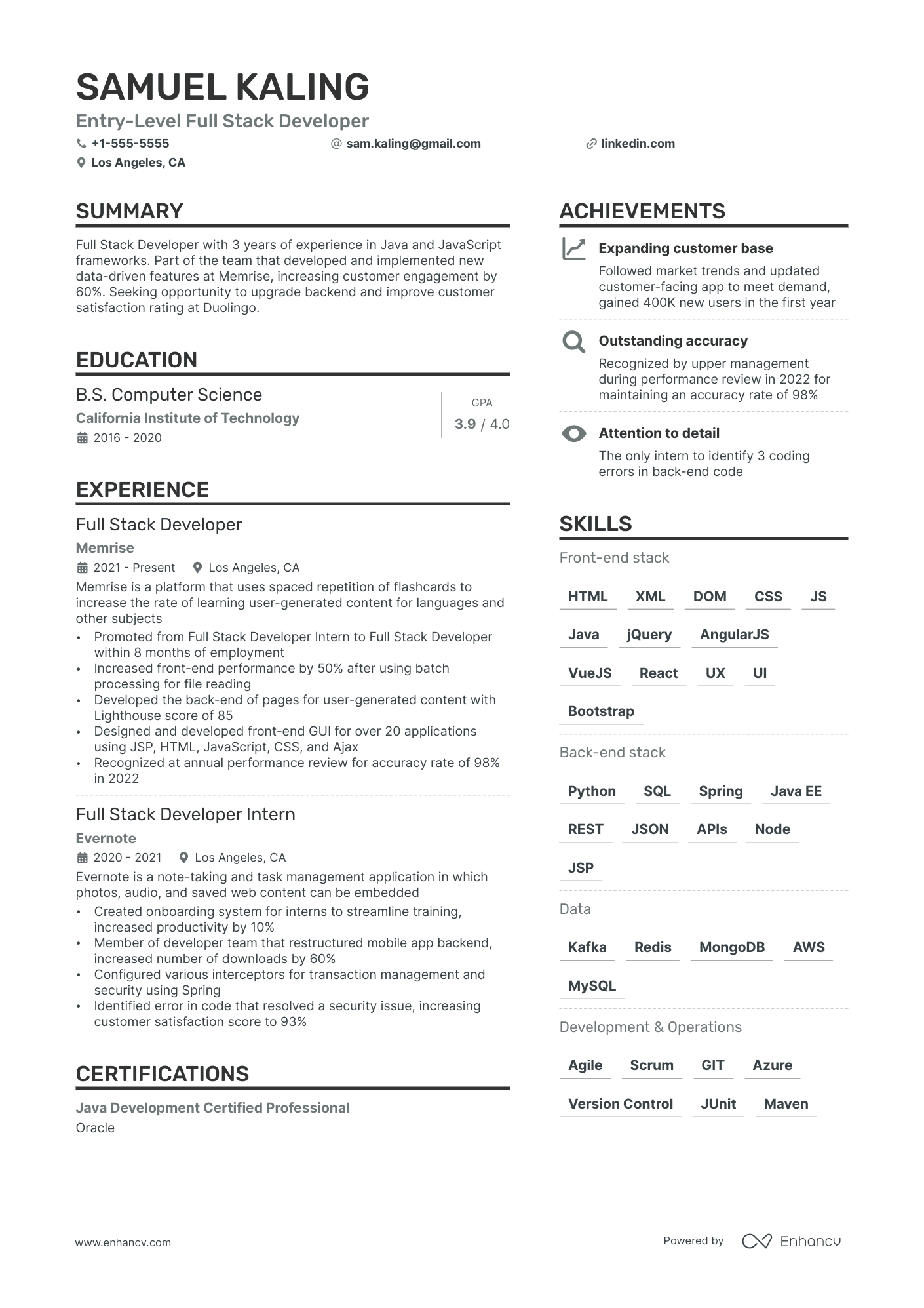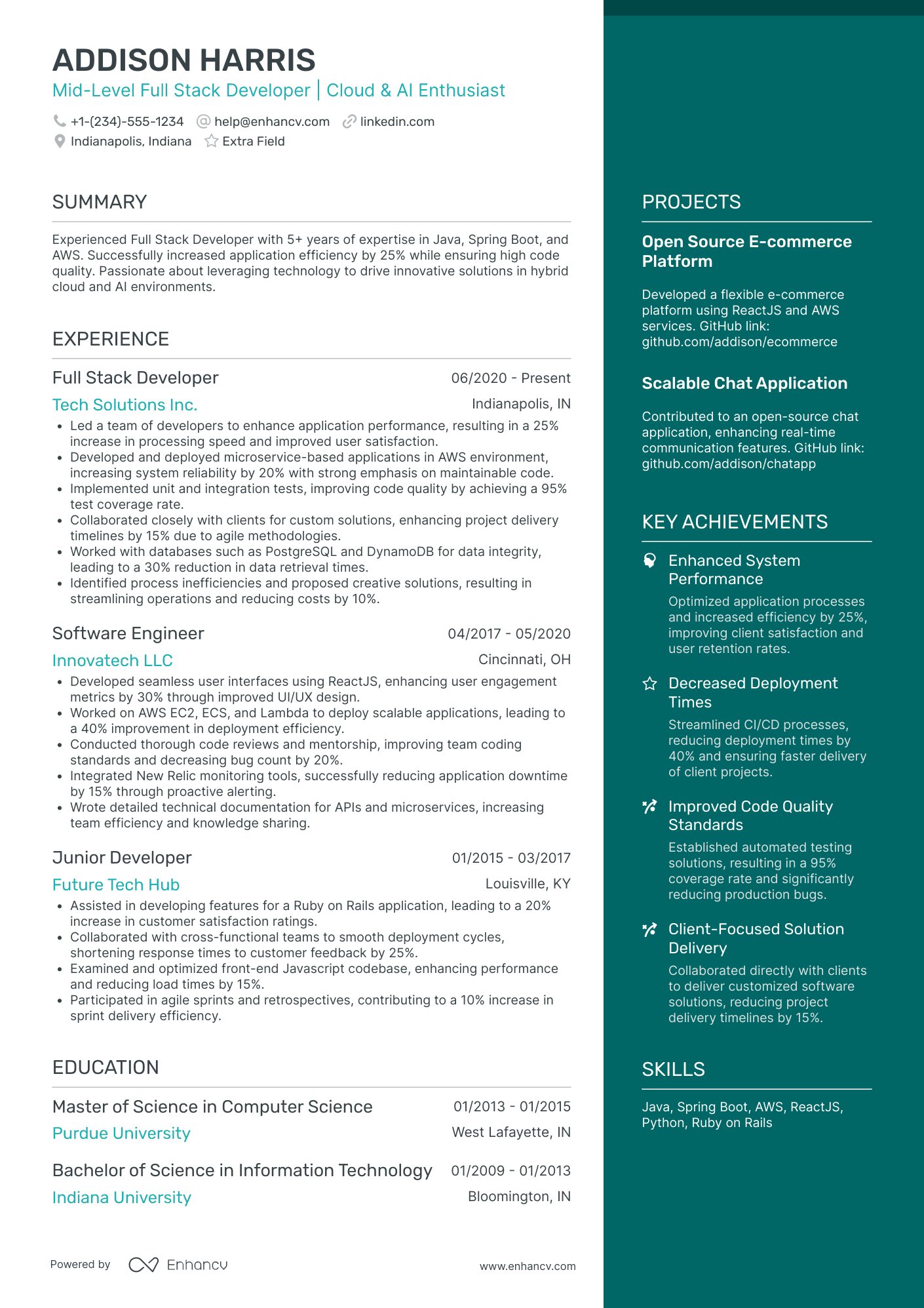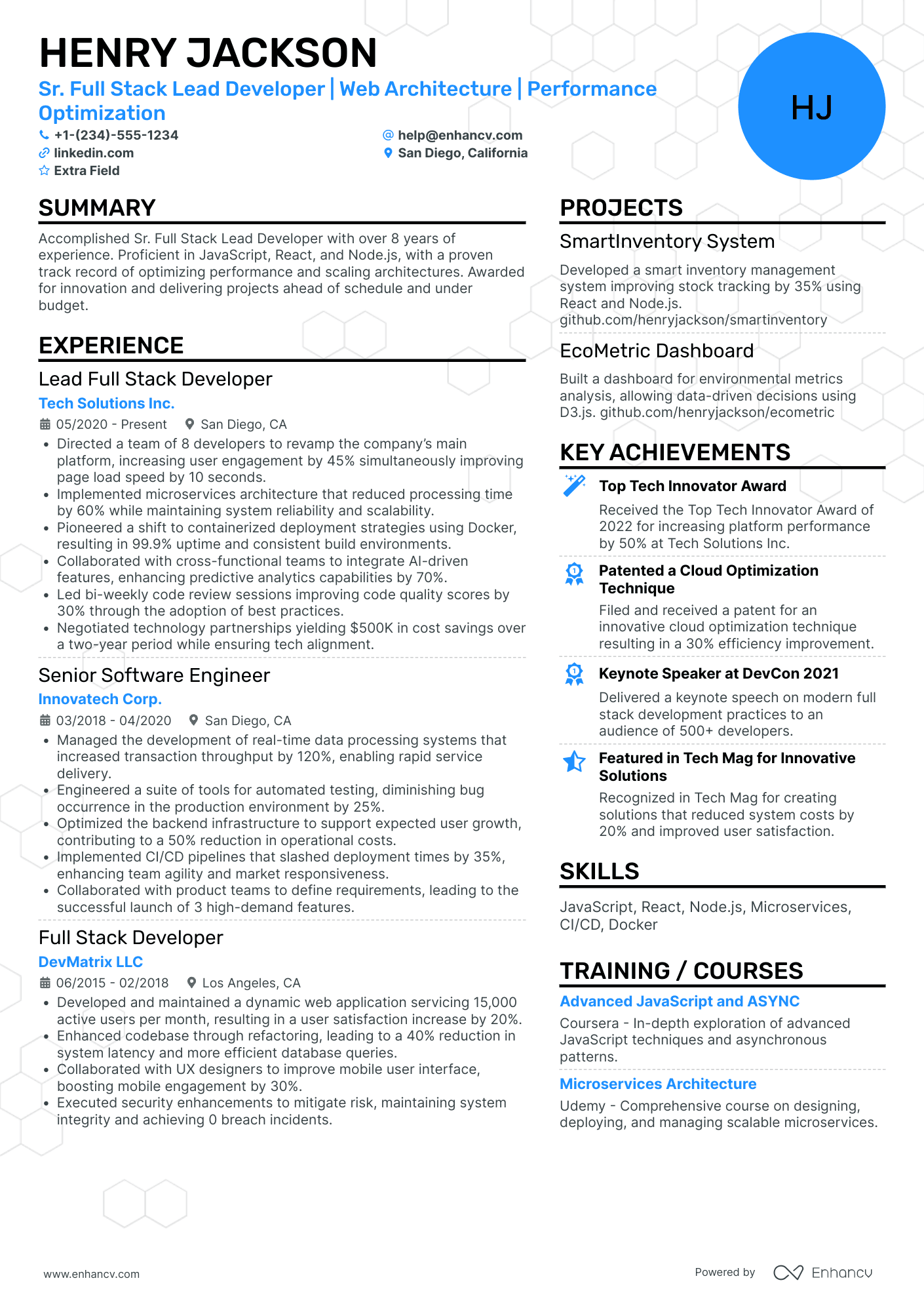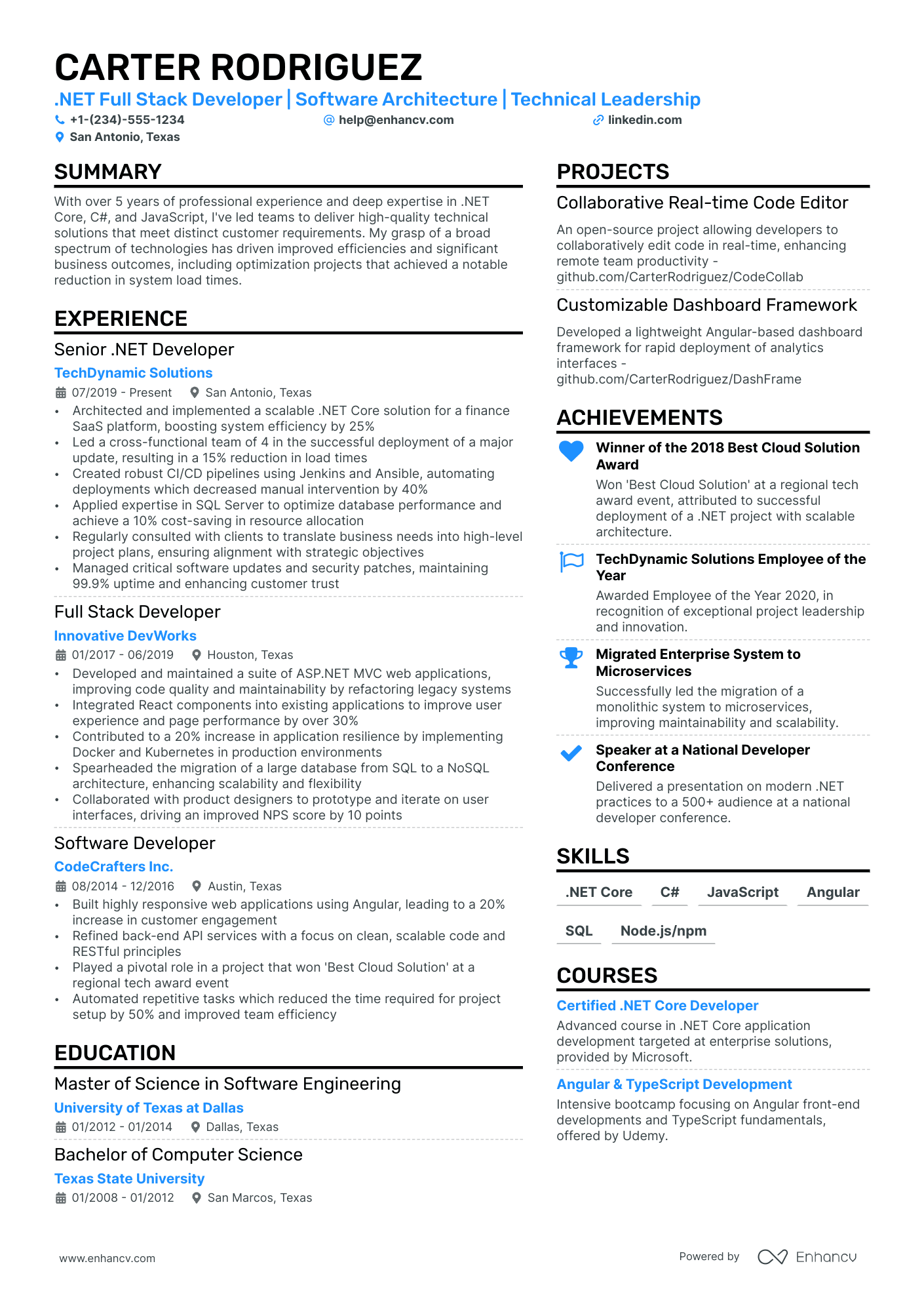As a full-stack developer, you've honed a diverse skill set, from server-side scripting to mastering client-side intricacies.
However, translating this expertise into a resume can be challenging.
In the sea of countless full-stack developer resumes, standing out is crucial. It's not enough to merely mention coding basics; it's about showcasing in-depth knowledge without creating a lengthy document.
Striking this balance is delicate; overdo it, and you might seem pretentious, underplay, and you risk appearing unprepared.
This guide is designed to help you craft that winning full-stack resume, complete with samples.
In this full-stack developer resume guide, you'll learn:
- Uncover the key components of a standout Full Stack Developer resume through a comprehensive example.
- Learn how to effectively detail both your front-end and back-end development experiences, showcasing projects and their impact.
- Grasp techniques for presenting your proficiency in various programming languages, frameworks, and tools.
- Understand the best practices for highlighting soft skills, collaboration efforts, and any continuous learning endeavors that elevate you as a Full Stack Developer.
Looking for other Information Technology resumes?
- Computer Science Resume
- Front End Developer Resume
- IT Project Manager Resume
- Information Technology Resume
- IT Manager Resume
- Python Developer Resume
- SQL Developer Resume
- Tech Resume
- Web Developer Resume
- Javascript Developer Resume
- Microservices Developer Resume
- Node JS Developer Resume
- PHP Developer Resume
- Programmer Resume
- Web Designer Resume
Once you finish reading this guide, you’ll find your resume completely reinvented.
Full stack developer resume example and what does it do right
- Strong educational foundation - holding an advanced degree from a prestigious institution can set a foundation for technical prowess and analytical skills.
- Quantifiable achievements - mentioning specific achievements with tangible outcomes such as increasing revenue through AI/ML implementations or leading high-value projects provides measurable evidence of impact.
- Leadership and team management - highlighting experience in building and leading teams, especially in Agile environments, showcases managerial skills and team collaboration.
- Industry-relevant certifications - including certifications from recognized institutions and organizations demonstrate specialized knowledge and a commitment to professional growth.
Full stack developer resume format and sections
Being a full stack developer doesn’t give you the license to whack a hiring manager with everything you know technically.
Instead, you should try to focus on showcasing that you’re the right “T-shaped” full stack dev for the job.
And, if you aren’t being careful enough, your resume might just say “I copy and paste code from Stack Overflow blindly and deploy it to production”.
- The best option for your full stack developer resume is the reverse-chronological resume layout.
- A full stack resume header should include the applicant's name, contact details, location, relevant platform links (like GitHub), and a personal blog link to effectively connect with potential employers.
- A full stack resume should include a header with title, professional summary, experience, skills, achievements, and certifications.
- A full stack developer resume should ideally be one to two pages long, depending on the individual's experience and achievements.
- A full stack developer resume should preferably be in PDF format.
This ensures that the formatting remains consistent across different devices and platforms. Additionally, PDFs are generally preferred by hiring managers as they are more secure and cannot be easily altered.
Wondering how your resume benchmarks against a leading ATS checker? Try it out below:
Consider the local standards – Canadian resumes, for example, may have a different format.
Is your resume good enough?
Drop your resume here or choose a file. PDF & DOCX only. Max 2MB file size.
The top sections on a full stack developer resume:
- Technical skills - this section is crucial for a full stack developer because it showcases the breadth and depth of their knowledge across both front-end and back-end technologies, ensuring they can handle the complete spectrum of development tasks.
- Work experience - by highlighting relevant roles and impactful projects, recruiters can gauge the applicant's hands-on experience and their capability to deliver tangible results in real-world scenarios.
- Education and certifications - including formal education and relevant certifications demonstrates a developer's foundational knowledge and commitment to continuous learning, both of which are essential in the ever-evolving tech landscape.
- Achievements - illustrating challenges faced and how they were overcome, especially with quantifiable results, can provide insight into a developer's problem-solving skills and their potential value to prospective employers.
- Summary or professional profile - a well-crafted summary gives a snapshot of the developer's career trajectory, core competencies, and value proposition, enabling recruiters to quickly ascertain if the candidate aligns with the role's requirements and the company's needs.
Your resume has to provide context appropriate information to show hiring managers that:
- You know the programming languages (server-side, client-side) and database technologies the role expects you to work on
- That you don’t cost them a century worth of refactoring once you write a module
- You’ve learned a lot and grown throughout your work experience
- Blind “Cmd + C” from Stack Overflow is not the way you code
- How you work with a team, and that you help others become better at their work
How to include full stack developer experience on your resume
When it comes to full stack development, we know it's more than just a list of jobs - it's about the awesome projects, the late-night coding, and the bugs you've triumphed over.
Let's dive into making your work experience section shine brighter than a freshly debugged program, highlighting not just where you've been, but the coding adventures you've had and the impact you've made.
Ready?
Let's make your resume pop!
- Start by listing your job title, the company's name, its location, and the time you spent there.
- Bullet out 4–6 key moments or tasks, shining a light on what you contributed and achieved.
- Tailor your experience by lining up your skills with what the job is looking for.
- Use the Problem-Action-Result method to frame those moments where you truly made a difference.
- Lead your bullet points with strong action verbs to make them stand out.
- Mention the team dynamics and the tech tools or frameworks you were working with.
- Lastly, put the spotlight on big achievements, making sure they shine brighter than the day-to-day tasks.
After reading your attention-grabbing summary, a hiring manager will want to dive deep into your work experience.
That means, you need to step back and see what programming languages the job demands.
Now, don't worry if you don't know all of these languages or frameworks. You still have a chance if you can show you learn quickly.
You resume skills will prove that.
But for now, let's take a look at a couple of resume experience section examples.
Two full stack developer resume experience section samples
Let’s say you’re going to send your resume to John, the (fictional) COO of Intercom. You wrote your resume experience like this:
- •Developed a ReactJS based application for inventory management. Created node services and stored data on MongoDB.
- •Implemented continuous integration and delivery
- •Learned new front-end technologies and implemented them
- •Built new API services for external partners
There are a couple of problems with this resume experience example.
First, to a hiring manager it would feel as if the candidate hasn’t put any effort into listing what they did.
Second, if you’re an experienced developer, this resume experience will get you rejected when it is placed between 100s of resumes.
Writing a ReactJS based application with NodeJS and MongoDB could mean a lot of things when you don’t give it context.
A hiring manager would usually try to get the following context from your experience section:
What was the quality of the front-end that you built? (Lighthouse score)
What aspects of the work were you truly passionate about? (front-end, back-end services, databases, etc.)
What did you actually learn and implement there?
Let’s rewrite this example into a version that gives hiring managers a better idea of what you’ve achieved.
- •Designed and wrote the front-end of our eCommerce application using ReactJS with 14,000 reusable components
- •Achieved a Lighthouse score of 100/100 on our frontend
- •Optimized service layers, request queues and MongoDB data model to handle request load of 74,000-96,000/sec during flash sales
- •Built a UI leadership group at FullStack Labs Inc. to mentor and train new engineers
- •Researched and documented needs of 150 external partners and built an API abstraction layer for seamless integration without breaking
- •Modernized our legacy Vendor management app originally built on Angular 2.0 to Vue.JS
What an improvement!
On average, a full stack developer handles more than 10 responsibilities and handles 5+ projects (big and small) in a year. To make sure you write the best work experience here, you need to pick your best 5 to make the cut.
Now let’s look at an example for a java full stack developer.
- •Built GIS software for City of New York
- •Responsible for design, development and analysis of the application
- •Refactored application and implemented security
- •Improved web application front end performance
What’s wrong with this example:
- Lists generic tasks and responsibilities
- No specific data or figures cited
- No industry software or programming languages mentioned
- •Designed and implemented GIS application for the City of New York to allow critical parts of the app to handle 1,000+ concurrent requests and also be multi-threaded.
- •Improved legacy front end by replacing it with AngularJS, Tomcat API, Java and Spring. Resulted into 50% faster loading times for our data heavy GIS application.
- •Refactored the application to incorporate security with micro service with Spring Boot, Java and AWS Cognito.
- •Worked with a team of 11 people, developers, QA and scrum masters
- •Built CI/CD pipelines using Jenkins, Docker, Kubernetes and custom scripts - helping teams deploy more than 30 times in a day
Not only will you win an interview call with such a full stack resume experience, but you appear as one of the most promising candidates too.
It really drives your full stack resume to perfection when you add job specific skills.
How to quantify impact on your resume
As a full stack developer, quantifying your resume gives concrete evidence of the difference you've made in past roles. It's not just about listing skills, but showcasing the real-world impact you've had, helping potential employers see your direct value to their business. So, what work achievements can be quantified?
- List the number of languages and frameworks you're proficient in - this quantifies your versatility and breadth of technical knowledge.
- Highlight the number of projects completed in each primary technology - demonstrating the depth of experience in specific technologies.
- Mention the percentage improvement in website performance or load times after your optimizations - showcasing your impact on user experience and efficiency.
- Specify the number of team members you've led or collaborated with on major projects - indicating your teamwork and potential leadership skills.
- Note any reduction in bugs or issues post-launch after your contributions - suggesting your attention to detail and commitment to delivering quality code.
- Detail the number of databases you've worked with or set up - highlighting your experience with data management and backend processes.
- State the percentage of revenue growth or user engagement from projects you've contributed to - showing your direct impact on business metrics.
- Include the number of continuous integration and continuous deployment (CI/CD) pipelines you've integrated - emphasizing your role in streamlining development workflows.
36 мost important full stack developer resume skills that you may want to add
You have some (or all?) of them. All you need is a little inspiration. So, here’s a list of technical and soft skills that you might want to add to your resume:
36 Тechnical skills for your full stack developer resume
- Javascript
- CSS and CSS3
- NodeJS
- jQuery
- PHP
- Python
- Django
- Flask
- Java
- HTML and HTML5
- Ruby and Ruby on Rails
- .NET
- Front end frameworks (Angular, React, Vue)
- Syntax knowledge of XML, JSON, etc.
- HTML, CSS3
- SourceTree
- APIs
- Stored Procedures
- Git
- HTTP & REST
- SQL
- SQL Server
- MySQL
- MongoDB
- PostgreSQL
- Restful API
- AWS
- SOAP
- Azure
- Unit testing
- Agile Methodology
- Frameworks
- User Interface
- Continuous Integration
- XML
- AJAX
While soft skills are a must-have for senior full stack developer job seekers, they carry importance on an entry level full stack resume too.
So, make sure to add some (or all) of the soft skills that you see below.
5 Soft skills that you should consider adding to your resume:
- Problem-solving
- Adaptability
- Communication
- Teamwork
- Time management
- Critical thinking
- Continuous learning
- Attention to detail
- Empathy
- Multitasking
- Creativity
- Self-motivation
- Project management
- Decision-making
- Conflict resolution
- Negotiation
- Active listening
- Stress management
- Assertiveness
- Organizational skills
How to list your certifications and education on your resume
Keep your education section basic. An education section generally includes only the school, degree, and years attended. If you graduated many years back, you may even choose to omit this section. Your experience is what recruiters want to see for senior positions.
It will be more beneficial to include your up-to-date certifications. These show your aptitude for continuous learning and skills improvement which is a highly sought after quality in the tech world.
Some of the most important certifications nowadays for full-stack devs are:
- AWS Certified Developer – Associate
- Microsoft Certified: Azure Developer Associate
- Oracle Certified Professional, Java SE 8 Programmer
- Certified ScrumMaster (CSM)
- Red Hat Certified Engineer (RHCE)
- Google Associate Cloud Engineer
- Docker Certified Associate (DCA)
- Certified Kubernetes Administrator (CKA)
- Cisco Certified DevNet Associate
- PMI Agile Certified Practitioner (PMI-ACP)
If you’re wondering how to feature those in different sections of your resume, check out our certifications on resume guide.
Writing a good full stack software developer resume objective or summary
Believe it or not, but there’s a COBOL code somewhere out there that’s going to outlive you in production.
Still, technology is ephemeral - your hiring manager knows that well. Full stack developers have to work with quickly evolving technology parts.
That’s why they’re concerned. They don’t want to hire someone who is going to fall short with the pace of change technology brings.
And, that’s why your resume summary shouldn’t reflect “my code will be unmaintainable after Angular 9.”
Instead, you should highlight that throughout your professional working experience, you’ve continued to grow and learn new systems and technologies.
It’ll be highly convincing for a hiring manager if they can see that you quickly adapt to technology changes and mastered building high performing systems and using them.
You can do that simply by adding the following to your full stack developer resume summary:
- Mention the front-end, back-end, and database technology that you’ve worked on
- Make sure these technologies/frameworks are relevant to the role
- Add details to showcase the scale of your experience and your business achievements
- The full stack resume summary examples below will show you the difference between using a good vs bad resume summary.
What’s wrong with this example:
- General terms with no quantifiable definition
- No specific accomplishments or achievements
A good resume summary should look something like this:
Much better!
This example uses industry specific terms and mentions an award the candidate earned in their field.
Optimize your resume summary and objective for ATS
Drop your resume here or choose a file.
PDF & DOCX only. Max 2MB file size.
Other resume sections to include
Depending on your industry, experience, and seniority, there are more sections that you can consider adding to your resume.
Sections like hobbies, volunteer work, and publications allow you to step outside the standard resume format and show some personality.
Even sections for language skills or certifications can make a big impact.
If you still have more to say and aren’t sure where to fit it onto your resume, consider whether or not a cover letter is a good fit for the full stack developer job you’re applying for.
How to put a projects section on a resume
For example, if you were asked to list a side project that’s all about scheduling app, there are better ways than just listing out the project specifics.
You can talk about how product development, requirement analysis, design and planning was a critical part of the project in addition to the technical details.
Doing that helps you plan on other applicant’s weaknesses and make your resume stand out.
Full-Stack Developer resume examples
By Experience
Senior Full-Stack Developer
Junior Full-Stack Developer
Entry-Level Full-Stack Developer
Junior Full Stack Developer
Senior Full Stack Developer
Mid-Level Full Stack Developer
Principal Full Stack Developer
Experienced Full Stack Developer
Entry-Level Full Stack Developer
Lead Full Stack Developer
By Role
Java Full Stack Developer
.Net Full Stack Developer
Angular Full Stack Developer
- Adding sections for other projects. You might have experience outside of traditional work history that speaks to your industry skills and abilities. Adding a separate section for projects, publications, or even hobbies can help you stand out.
- Make a good impression with your summary. Catch the attention of recruiters quickly with a strong summary. Concisely and professionally summarize your industry experience, a major accomplishment, and the impact you’ll bring to the new role.
Python Full Stack Developer
- Including soft skills as strengths. This candidate creates a section to expand on their greatest strengths. Soft skills are open to interpretation and you don’t want to leave anything to chance. Provide examples so recruiters know exactly what you mean by “time management.”
- Choose a customized job title. Picking a niche can give you an advantage when competing with a ton of other qualified candidates. Tailoring your job title to the role you’re applying for will catch the recruiter’s eye right away.
Full-Stack Software Developer
Full-Stack Application Developer
Chatbot Full-Stack Developer
React Full-Stack Developer
- Tell your target company how you’ll help them. Research your target company and find out their needs and biggest issues. Use your resume to show how you can provide solutions. Include similar achievements you’ve had in previous roles.
- Optimize readability. Resume content is important, but so is the structure. Don’t let your resume end up in the trash because it was difficult to read. Make it appealing to recruiters with formatting, fonts, and colors that are clear and easy on the eyes.
Key takeaways
- Add a resume header and make sure to have your GitHub/Stack Overflow/personal blog links in it.
- Total years of experience, tech skills, and proud achievements should be outlined in your resume summary.
- Show that you not only know what the role demands, but you’ve consistently learned and grown within your professional working experience.
- Make a separate section for your resume skills and add both technical and soft skills to it.
- Consider adding separate sections for recognitions, achievements, and certifications.

